5 Tips for Helping a Fearful Flyer
You’ve boarded a plane and found your seat, stowed your things and buckled up. The plane makes its way onto the runway and, after a short wait, the acceleration for take-off begins.
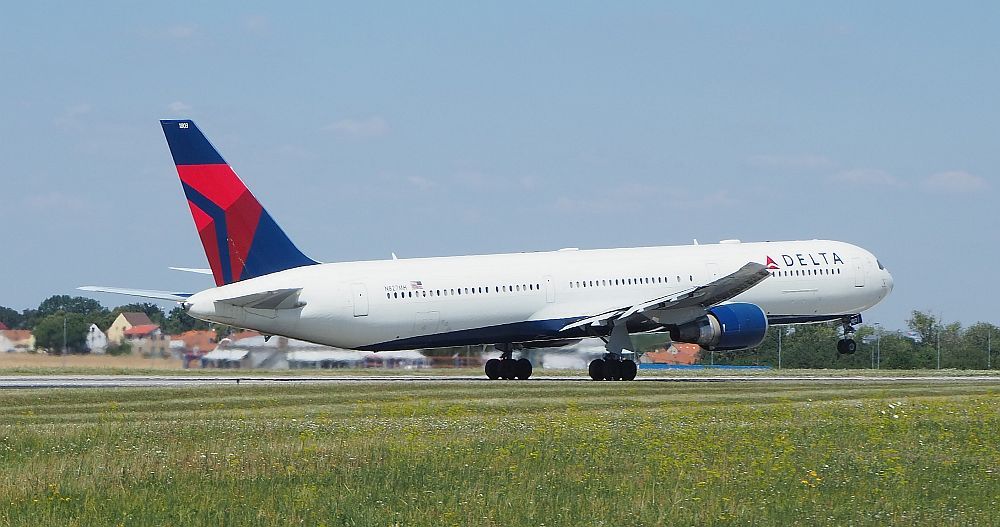
You’re reading the book you brought along and don’t pay any attention to what the plane is doing, but, as it speeds up, something breaks your focus on your reading. The man sitting next to you is sitting bolt upright, clenching the armrest between you with all his strength.
You turn to look at him, and immediately recognize what’s going on: he’s a fearful flyer. What for you means nothing but boredom and an excuse to get some reading done is for him a trigger for abject terror.
You could just ignore him and go back to your reading. For the purposes of this article, I’m assuming you’re more compassionate than that and want to help him in some way.
So what can you do about it? How can you help this stranger who will be sitting next to you for the next several hours? I am one of those fearful flyers, and I can share with you the sorts of behaviors that have helped me over the years.
1. Talk
You may be one of those people who doesn’t want to talk to your neighbors on a plane. You’d be doing him a real kindness, though, if you start a conversation. It doesn’t matter what you talk about: just that you talk. It will help distract him from the various noises the plane is making. Those bumps and whines may be insignificant to you, but to him they might be signs of engine trouble.
This doesn’t mean you have to spend the whole flight speaking to him. Chances are he just needs help during the parts of the flight that scare him. Typically, that means the take-off, the landing, and any periods of turbulence. Once the plane reaches altitude and the seatbelt lights go off, he can probably focus on reading or watch a movie calmly.
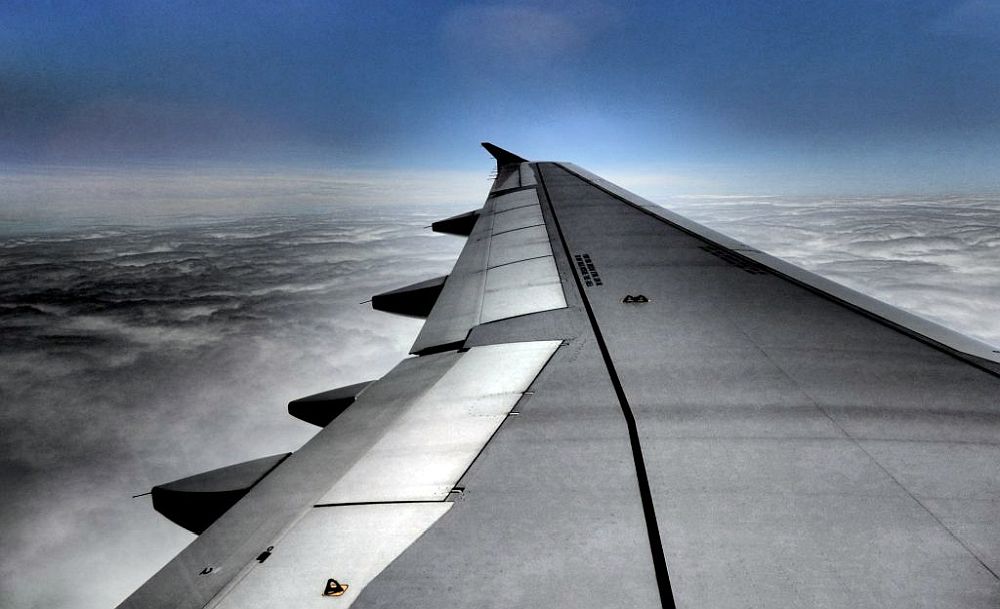
2. Listen
Don’t bring up the topic of flying unless he brings it up. Some fearful flyers might say quite openly that they’re afraid, and might want to tell you why. Many, though, would rather talk about pretty much anything else, to avoid even thinking about flying. Let him talk. Ask leading questions to keep him talking. Look him in the eye and listen, or at least act like you’re listening.
3. Stay calm
For me, a key to dealing with my own fears—which, like every fearful flyer, I know are completely ridiculous—is seeing other people who keep calm. When the turbulence is bad, or at least it’s bad in my irrational head, it always helps me to see the flight attendants calmly going about their business, pouring coffee, serving food, and so on. They fly all the time, and if they’re calm, this level of turbulence must be normal.
If the plane banks, or turbulence sets in, or you start the descent, for example, don’t stop your conversation or tense up. Ignore these changes just as you normally would and continue talking. Your aura of calm will help the fearful flyer sitting next to you.
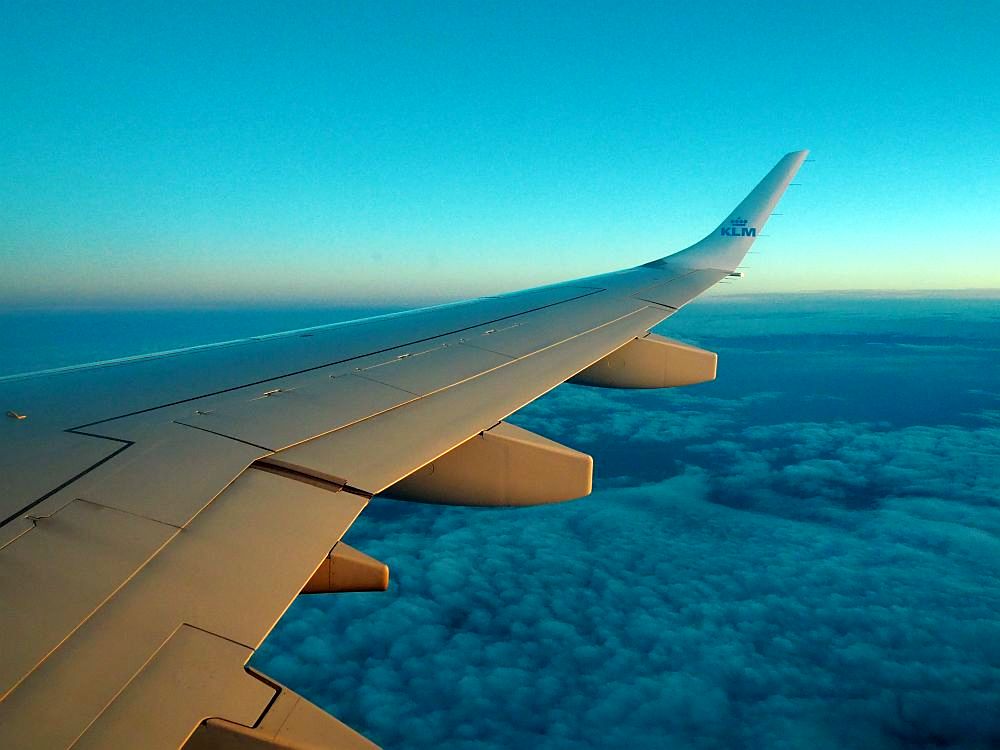
4. Hold hands
This one is a bit more extreme. I discovered years ago that it helped me to hold hands with the person next to me. I never would have dared to take the hand of a stranger until, on one flight, I was so busy being scared that I didn’t notice the person next to me. During a moment of turbulence, she suddenly grabbed my hand, then dropped it quickly, apologizing to me. I assured her that I didn’t mind at all, and whenever the turbulence started up again, we held hands. It helped! Completely irrational, I know, but that’s what phobias are about!
Don’t just take the person’s hand without permission, of course. You don’t want him to think you’re making a pass (unless you are!). However, if the person is visibly terrified, and you’ve already started up a conversation, go ahead and offer: “If you feel like it would help, you can hold my hand.”
Here are some other articles that might interest you too:
One time on a flight from the Netherlands to Turkey, I was sitting next to a Turkish woman who started praying before we even took off. I tried to start a conversation with her but we were limited to only the most basic exchange of information; her Dutch was minimal and her English and my Turkish were non-existent. I managed to find out that she hadn’t flown in 20 years and that she was returning to Turkey to see her mother who was very ill.
It was clear without words, though, that she was terrified of flying. I wasn’t feeling too great about flying either. So as soon as I started getting nervous (For me, that’s typically when there’s turbulence.), I simply took her hand. She startled, but then smiled at me. We spent most of that flight holding hands, and it helped both of us.
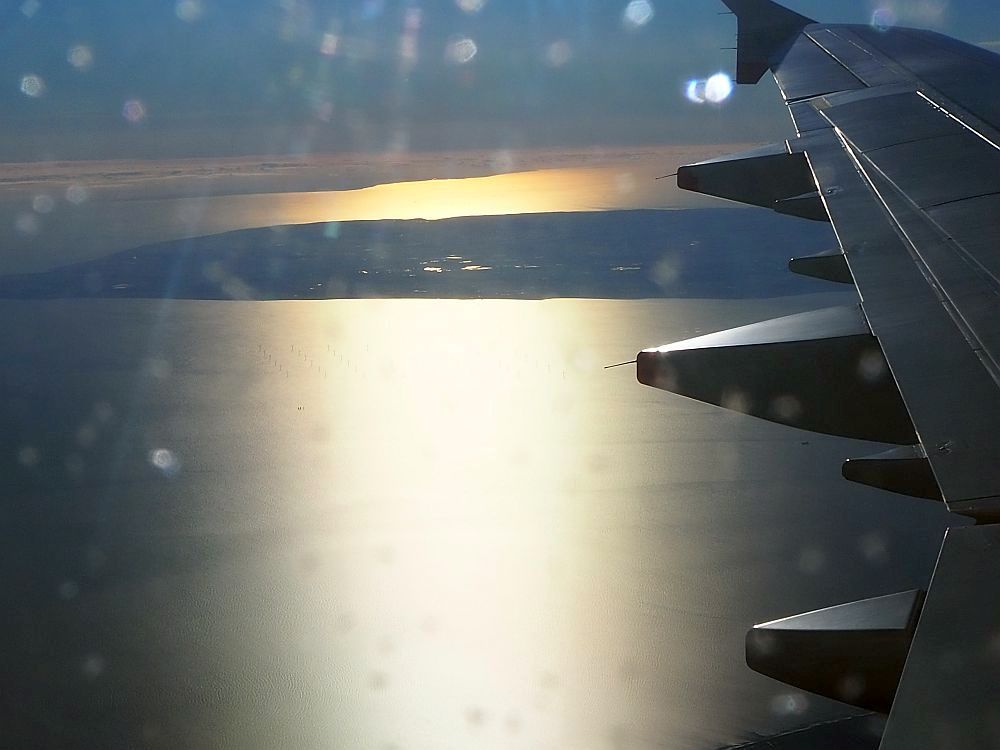
5. What not to do to help a person who is afraid of flying
Don’t joke about it! Jokes about airplane crashes or terrorists or engines falling off are most emphatically not funny to fearful flyers. It’s downright cruel to joke about these things in their presence.
Don’t lecture the person about how flying is safer than any other form of transportation. He undoubtedly knows that already. It’s in the nature of phobias that they are irrational. Reminding him of his irrationality will only exacerbate the embarrassment and shame that he already feels. You might have a fear of snakes or spiders or water; this is no different.
If you are not afraid of flying, please keep these tips in mind next time you fly. And if you’re phobic like me, don’t be afraid to ask for reassurance from your neighbor or start a conversation with him. The distraction helps!
Are you afraid of flying or have you ever found yourself sitting next to someone who was? How did you deal with it?
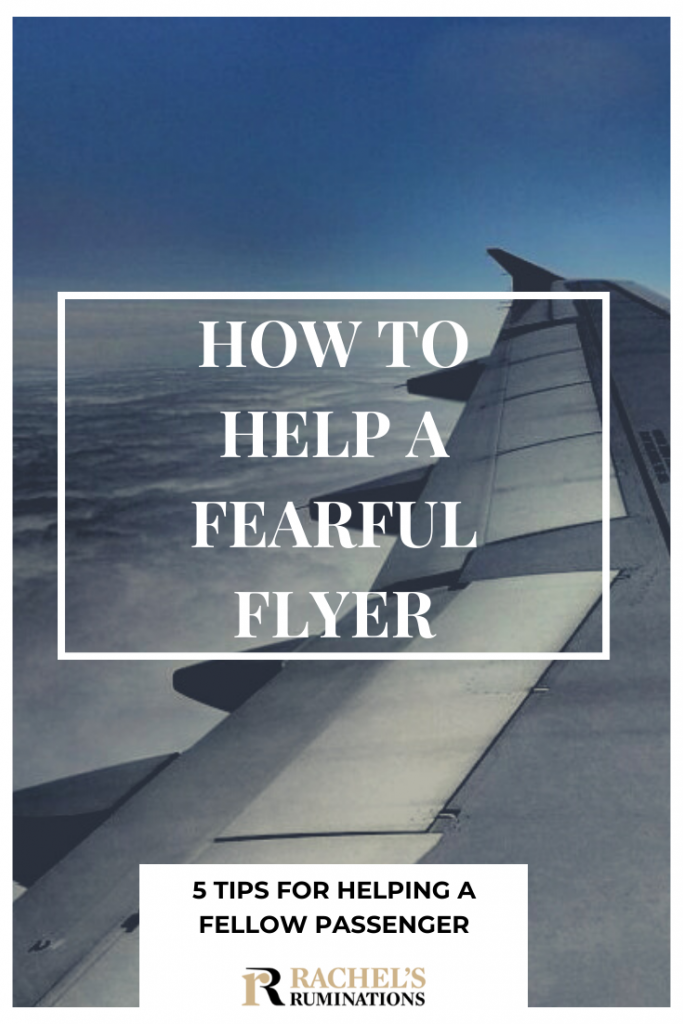


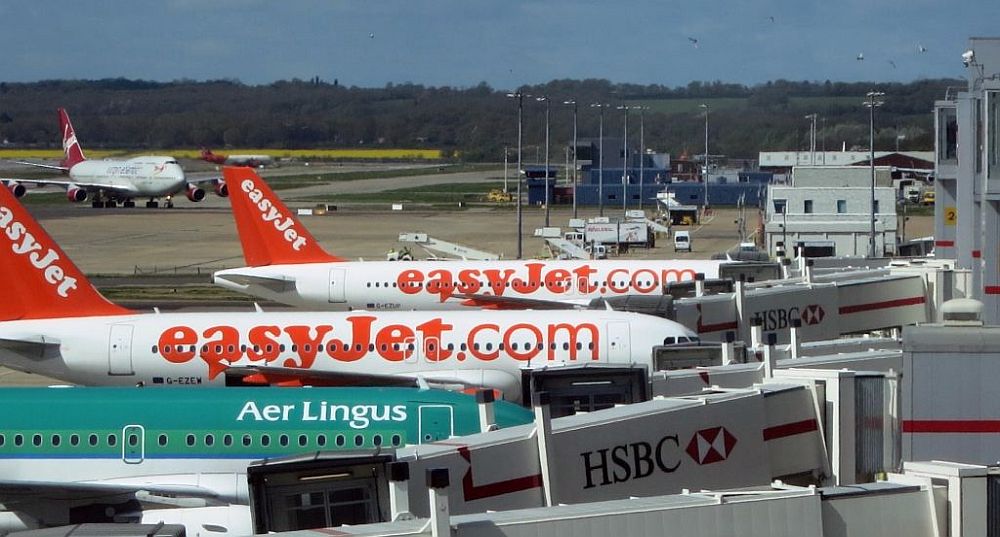

I hate flying – I do listen to the engines – it’s that noise more than anything that is key. Hate it but do it a LOT. Am glad every time I land!
I wear headphones and play music loudly to block out the noises. Otherwise I’m worrying whether they’re normal the whole time. It’s the movement that bothers me most, especially turbulence!
Hi Rachel. Great post. I’m one of those people who loves to fly (or at least I have no fear). I’ve never set beside someone who has the fear. If I ever do, I will keep these tips in mind, and hopefully help them out just a little.
Maybe I’m more aware of it because I’m scared, but I often seem to end up next to fearful flyers!
Love flying, but empathetic to those that find it terrifying … great tips to help them cope!
Thanks! I wish I could enjoy flying. You’re lucky!
My husband used to be afraid of flying and sometimes had panic attacks. He learned how to deal with panic attacks and put it into action when flying. Now after many flights he is generally much more relaxed about it. Holding hands would be comforting if both people were scared. I like this thoughtful post.
Even if just one of the two people is scared (i.e. me), it helps! I’m a lot more relaxed than I used to be, but the panic still rears its ugly head if the turbulence is bad.
You are so very kind to help out strangers. I overall don’t mind flying, but turbulence sends my own mind and stomach into a tizzy. When my kids were young, it was really hard to help them through their own nervousness when I felt like I was going to throw up at any moment. I like your tips and will keep them in mind, perhaps for my own self.
Funny, despite the fear I never get nauseous. It’s not really about the motion of the plane; it’s about my fears about what the motion might mean! When my kids were little I tried very hard not to let them see my fear, because kids learn it from their parents. I was successful with my daughter, but less successful with my son.
I hate heights but I am not afraid of flying. Weird, I know. I have sat next to people who are scared of flying and I find it within my best interests to be lovely to them, and also – I just get it.Most people have a fear of something or other, and that is just the way it is. My friend will not come in our house until I make sure there are no spiders. So I make sure the spiders leave for her. It is just the way it is. Don’t hate me, but I love turbulence, it rocks me to sleep.
I don’t hate you; I’m envious of you! I so wish I could be one of those people who can just sleep through a whole flight! I only hate them when they’ve passed out in an aisle seat, blocking me in!
Great article. Really compassionate. I’m OK flying and don’t recall siting beside anyone who was scared of flying but your post had some great pointers. Thanks for sharing.
I seem to have some sort of sixth sense for detecting them! I suppose it’s the fellow feeling…
Some great tips here! On my most recent flightfrom Dublin my seat mate was a fearful flyer but mostly due to imbibing too much Guinness the night before. The motion sickness bag was put to the full test. Good for you for holding hands with your seat mate. I did suggest ginger ale in the hopes in might help
Was he actually afraid, or just drunk? or both? I used to drink on flights to calm my nerves, but gave that up. I would end up still afraid, but also a bit drunk, which just exaggerated my fears. Now I just drink lots of water.
I was a very fearful flier before I met David. Obviously I have managed to get over it but we still hold hands on every takeoff. Good advice, thanks.
That’s sweet!
I’ve never been aware of sitting next to a fearful flyer but I’ll remember to look out next time. Good tips!
Thanks, Karen!
I’m not afraid of flying but I have to admit, I tolerate turbulence less and less the older I get. It is still the best and fastest way to get to exotic destinations, so I’ll always fly to get to adventures!
I read somewhere that turbulence is getting worse on average and will continue to do so. Something to do with more planes in the air. One thing that helps me is thinking about the worst turbulence I’ve experienced, which makes what I’m feeling now seem not nearly as bad!
And yes, I feel the same way: it’s worth it for the travel!
Hi Rachel. I really love this post because in as much as I enjoy seeing different parts of the world, I’m a fearful flyer. Turbulence is what really puts me off! Your tips will help through my journeys. Thanks
Glad to help, Bola! I wonder how many of us travel bloggers are fearful flyers…
Wow I never knew how much fear of flying affects people. My friend is terrified of planes and the last trip we went on she had a panic attack. Thank you so much for telling me how to help her overcome that fear!
Glad I could help!